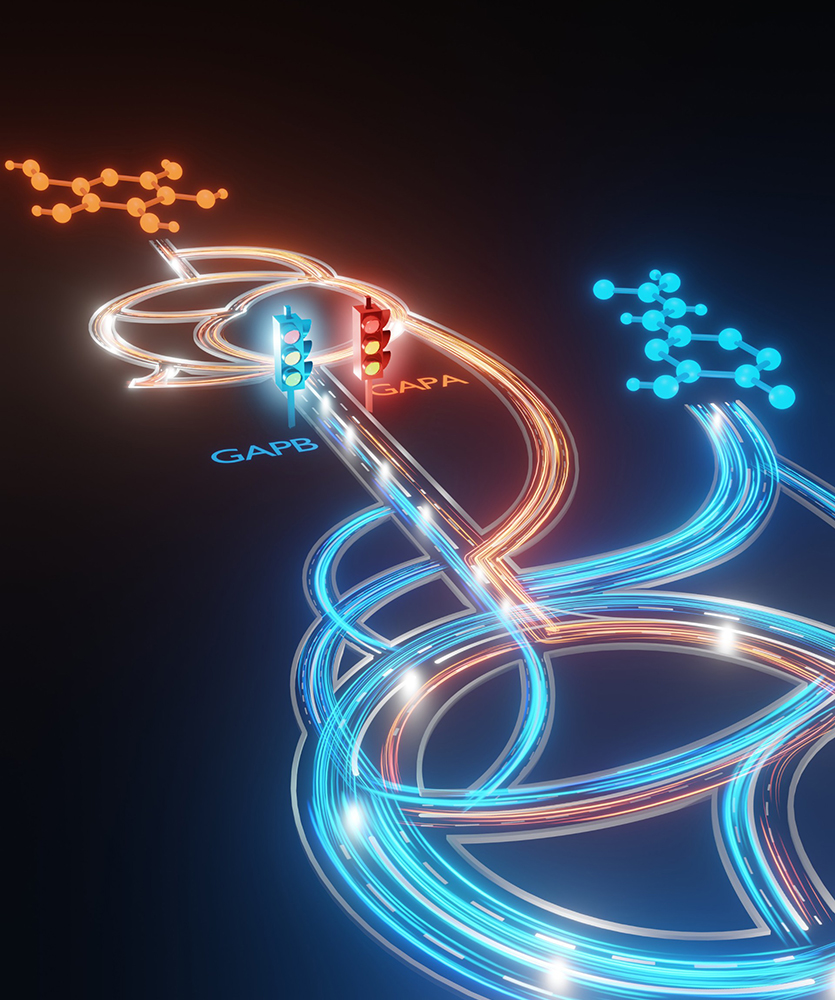The Problem
Scientists didn’t understand how bacteria divide up carbon sources into different paths for energy or to build new materials.
Scientists didn’t understand how bacteria divide up carbon sources into different paths for energy or to build new materials.
Researchers discovered that two versions of a single enzyme act as “traffic controllers,” directing carbon flow inside bacterial cells.
This insight could help engineers design bacteria that transform waste carbons—like plant matter or plastics—into routes for valuable chemicals and fuels.
Professor Ludmilla Aristilde; Professor Niall Mangan; Postdoctoral researcher Nanqing Zhou; PhD students Xinyu (Norah) Chen, Caroll Mendonca, and Stefan Pate; Undergraduate researcher Kelly Teitel

When bacteria eat different kinds of food like sugars or more complex carbon compounds, they can send those nutrients down different “roads” inside a cell to make energy and build new materials.
A new study from Northwestern Engineering’s Ludmilla Aristilde found that a single enzyme, glyceraldehyde-3-phosphate dehydrogenase (GAPDH), acts like a traffic light that decides which road the carbon from different “foods” takes. By tracking how carbon atoms move through bacterial cells using special isotope labels attached to different types of food for the bacteria, her team showed that two versions of this enzyme send metabolism in opposite directions. By using these labeled carbon atoms, researchers can literally watch how the cell decides to metabolize food for energy and building blocks.
The finding helps explain how Pseudomonas bacteria, common in soil and known for consuming a wide range of carbon sources from plant waste to plastics, manage their internal “carbon traffic.” The insight could guide efforts to harness these bacteria for recycling waste or producing valuable materials more efficiently.
The discovery not only deepens understanding of bacterial metabolism but also points to practical applications in biotechnology, such as developing microbes that process carbons from different waste sources into useful chemicals or fuels.
“Understanding how the metabolism in Pseudomonas species operates is very important to engineer the traffic of carbon towards biotechnology targets such as the synthesis of valuable chemicals from complex wastes,” Aristilde said.
An expert in the dynamics of organics in environmental processes, Aristilde is a professor of civil and environmental engineering at the McCormick School of Engineering and a member of the Center for Synthetic Biology, International Institute for Nanotechnology, and Paula M. Trienens Institute for Sustainability and Energy. She presented her latest work in the paper “Glyceraldehyde-3-Phosphate Dehydrogenase Homologs as Bifunctional Gatekeepers of Metabolic Segregation in Pseudomonas Putida,” published Nov. 19 in the academic journal Proceedings of the National Academy of Sciences.

Until now, scientists had only guessed that GAPDH might help control which way carbon moves inside bacterial cells, after observing negative consequences on growth after removing the enzyme. Aristilde’s team was the first to show directly how GAPDH is involved in controlling carbon flows for different carbon sources using advanced metabolomics tools to track how carbon atoms flow through metabolism. They discovered that bacteria fine-tune the balance between two different versions of GAPDH to decide which direction the enzyme reaction is operating to direct flow of carbons when cells break down food for energy or build new materials. This finding shows how bacteria adapt to different food sources, from natural organic matter in soil to waste materials in industrial recycling strategies.
Most enzymes that can work in two directions simply respond to what materials are available. But in this case, the traffic flow depends on how much of which version of GAPDH is present, with each version specialized to control movement in one direction.
This new paper builds directly on Aristilde’s earlier work uncovering that Pseudomonas putida processes different carbon sources unequally when multiple types of nutrients are available. In that 2019 study, her team showed that carbons from sugars and other compounds follow distinct routes inside the cell. The new research takes the next step by identifying how this separation happens. By pinpointing two versions of a key enzyme that act as directional “gatekeepers,” Aristilde and her team reveal the molecular mechanism that controls this metabolic segregation—solving a question that had remained open for years.
“While this segregation of carbon metabolism has since been shown to be a common phenomenon in these Pseudomonas species building on our previous publication, what controls this segregation had remained unknown,” Aristilde said. “The current study addresses this.”
Aristilde said, moving forward, important next steps will focus on figuring out how to manipulate the dual functions of GAPDH dehydrogenase to control the flow of carbon from different types of nutrients. This could allow researchers to program bacteria to channel carbons along specific pathways for more efficient production of desired chemicals or fuels.